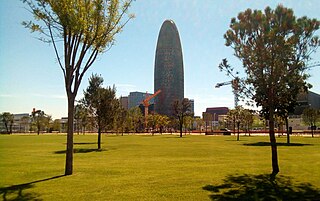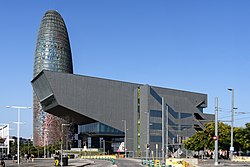
Tourism in Spain is a major contributor to national economic life, with foreign and domestic tourism contributing to about 12.4% of Spain's GDP. Ever since the 1960s and 1970s, the country has been a popular destination for summer holidays, especially with large numbers of tourists from the United Kingdom, Ireland, France, Germany, Italy, the Benelux, and the United States, among others. Accordingly, Spain's foreign tourist industry has grown into the second-biggest in the world.

Lluís Domènech i Montaner was a Catalan architect who was very much involved in and influential for the Catalan Modernisme català, the Art Nouveau/Jugendstil movement. He was also a Catalan politician.

The Museu Nacional d'Art de Catalunya, abbreviated as MNAC, is a museum of Catalan visual art located in Barcelona, Catalonia, Spain. Situated on Montjuïc hill at the end of Avinguda de la Reina Maria Cristina, near Pl Espanya, the museum is especially notable for its outstanding collection of romanesque church paintings, and for Catalan art and design from the late 19th and early 20th centuries, including modernisme and noucentisme. The museum is housed in the Palau Nacional, a huge, Italian-style building dating to 1929. The Palau Nacional, which has housed the Museu d'Art de Catalunya since 1934, was declared a national museum in 1990 under the Museums Law passed by the Catalan Government. That same year, a thorough renovation process was launched to refurbish the site, based on plans drawn up by the architects Gae Aulenti and Enric Steegmann, who were later joined in the undertaking by Josep Benedito. The Oval Hall was reopened for the 1992 Summer Olympic Games, and the various collections were installed and opened over the period from 1995 to 2004. The museum was officially inaugurated on 16 December 2004. It is one of the largest museums in Spain.

Avinguda Diagonal is the name of one of Barcelona's broadest and most important avenues. It cuts the city in two, diagonally with respect to the grid pattern of the surrounding streets, hence the name.

Plaça de les Glòries Catalanes, most often shortened to Glòries, is a large square in Barcelona, first designed by Ildefons Cerdà to serve as the city centre in his original urban plan, but nowadays relegated to quite a secondary position. It is located in the Sant Martí district, bordering Eixample, at the junction of three of the city's most important thoroughfares: Avinguda Diagonal, Avinguda Meridiana and Gran Via de les Corts Catalanes.

Glòries is a station in the Barcelona Metro network, at the boundary between the Eixample and Sant Martí districts of Barcelona. It is served by TMB line L1. The station is named after the nearby Plaça de les Glòries Catalanes.

Albert Ràfols-Casamada was a Spanish painter, poet and art teacher involved in the vanguard movements of his time. He is considered one of the most important, multifaceted Catalan artists of his time. His artwork began in the post-expressionist, figurative sphere but soon developed into his own abstract style grounded in a poetic rendering of everyday reality.

The Royal Palace of Pedralbes is a building placed in the middle of an ample garden in the district of Les Corts, in Barcelona. From 1919 until 1931 and since 1975 it has been the official residence for the Spanish royal family when they visit the city, although they currently prefer the Palace of Albéniz. It also houses the Ceramic Museum, the Textile and Clothing Museum and the Decorative Arts Museum, both part of the Disseny Hub Barcelona and is the permanent seat of the Union for the Mediterranean (UfM).

The Biblioteca Museu Víctor Balaguer is located in Vilanova i la Geltrú, Province of Barcelona, Catalonia, Spain and was founded in 1884 by Víctor Balaguer so as to thank the city for its support during his politician career. Since 2000 the museum is part of the National Art Museum of Catalonia and the library is part of the National Library of Catalonia.

Casa Bloc is a residential building built between 1932 and 1936 located at 101 Passeig de Torras i Bages, in the Sant Andreu district of the city of Barcelona. Its architects were Josep Lluís Sert (1902–1983), Josep Torres Clavé (1906–1939) and Joan Baptista Subirana (1904–1978), all members of GATCPAC (Catalan Group of Architects and Technicians for the Progress of Contemporary Architecture). Catalan architects of the Second Republic, brought together by the GATCPAC, proposed a new way of living that was just, accommodated co-existence and defended the collective identity. The creation of Casa Bloc was one of the first steps towards dignifying workers' living conditions. As a result of the Spanish Civil War, the project was cut short. In 2012, after a careful restoration by the Institut Català del Sòl and Institut de Cultura of Barcelona through the Disseny Hub Barcelona, the doors to apartment number 1/11 are open and furnished just as its creators had originally wanted.

The Museu de les Arts Decoratives, in English Decorative Arts Museum, is a museum opened in 1932 and located in the Palau Reial de Pedralbes in Barcelona. Created in 1932, this historic museum contains a rich and diverse collection of European decorative arts, from the Middle Ages to the Industrial Revolution. In 1995, the museum extended its boundaries with the incorporation of design, thus converting it into the first and only statewide museum concerned with the preservation and exhibition of Spanish industrial design. The collections of the Museu de les Arts Decoratives were created from an important resource of industrial design and decorative art objects, that included salvers, carriages, furniture, wallpaper, clocks, tapestries and glasswork.

The Museu Tèxtil i d'Indumentària, in English Textile and Clothing Museum, was a museum opened on 1982 and located in the Palau Reial de Pedralbes in Barcelona. The museum possessed countless objects and pieces of major artistic and historical value that make up their collections of garments, fabrics and jewellery. Regarding their collection of clothes, the museum allowed you to take a journey through the history of textiles, from the 16th century right up to the modern day. The museum's collections included Coptic, Hispano-Arab, Gothic and Renaissance fabrics, as well as embroidery, a section on lacework and a collection of prints. The jewelry collection comprised approximately five hundred pieces that were made and produced in Spain.
The Gabinet de les Arts Gràfiques, in English Graphic Arts Cabinet, is a museum opened in 1942 and located in the Palau Reial de Pedralbes in Barcelona. Together with Museu de les Arts Decoratives and the Museu Tèxtil i d'Indumentària is part of the Disseny Hub Barcelona.

The Castle of the Three Dragons, is the popular name given to the modernisme building built between 1887 and 1888 as a Café-Restaurant for the 1888 Universal Exposition of Barcelona by Lluís Domènech i Montaner. This name was probably adopted from the 1865 play by Serafí Pitarra.

The Centre de Documentació i Museu de les Arts Escèniques, also known as MAE, is a centre for information and research on the performing arts in Catalonia, Spain. The centre has an extensive library, an archive and collections from the Institut del Teatre, which specializes in theatre, dance, opera, zarzuela, music hall, magic and circus performances. Its major collections encompass Catalonia and the Spanish Golden Age. The centre also has posters, programmes, photographs, pictures, puppet theatres, set designs and costumes which are exhibited in temporary exhibitions and online, since it has no permanent exhibition space. The museum is a member of SIBMAS and ENICPA, and is part of the ECLAP European Project. In Catalonia, it is involved with the Consortium of Academic Libraries of Catalonia.

The following outline is provided as an overview of and topical guide to Barcelona:
Pau Rigalt i Fargas was a Catalan painter and scenographer. He was one of the pioneers of Neoclassicism in Catalonia.
Carme Llorens i Gilabert was a Spanish Catalan enameler and jeweller.
Pilar Vélez Vicente, is an art historian and cultural manager. From 2012 until her retirement in 2022, she was the director of the Design Museum of Barcelona, the product of the integration of the collections of the Decorative Arts Museum, the Ceramics Museum, the Museum Textile and Clothing and the city's Graphic Arts Office. Pilar Vélez replaced Marta Montmany in the position, when she retired during the spring of 2012.


















